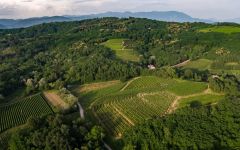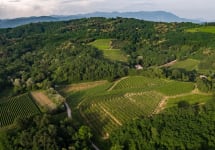Attems Sauvignon Blanc 2020



Product Details
Your Rating
Somm Note
Winemaker Notes
Clear, bright and with greenish reflections, the wine explodes on the nose with boxwood, lychee and acacia flowers. It is a wine with persisting aromas, and more mature notes of white melon. The flavor is lively and intense with pleasant citrus and scotch broom flowers.
Attems Sauvignon Blanc’s crisp, refreshing character renders it delicious as an aperitif, but it partners with foods as well, with poultry and similar light meats, and with fish that is grilled or sautéed with potatoes, asparagus, or mild vegetables, and first courses with cheese-based sauces.
Other Vintages
2022-
James
Suckling
-
James
Suckling -
Wine
Enthusiast
-
James
Suckling
-
James
Suckling
-
James
Suckling
-
James
Suckling -
Wilfred
Wong
-
Wine
Spectator
-
James
Suckling
-
Wine
Spectator
-
Wine
Spectator
-
Wine
Spectator





The world-famous Attems wines are grown in Italy's renowned Collio DOC in the northeastern part of the country, bordered by the Alps to the north and the Adriatic Sea to the south. This geography creates a temperate microclimate, and the region's marl and sandstone soils make it perfect for Pinot Grigio and Sauvignon Blanc, as well as for the native Ribolla Gialla and Tocai Friulano that have been harvested here since at least as early as the 18th century.
The Attems family winemaking lineage dates back nearly a millennium. In 1106, records show that the Bishop of Salisbury gave them the estate for the purpose of cultivating vineyards and making wine. After 900 years of wine production, Attems aligned with the renowned Marchesi de' Frescobaldi, one of Italy's most revered wine families. Douglas Attems and the Frescobaldi family celebrate a legacy of friendship founded during their years as students at the University of Florence. The partnership understands that a wine's quality and personality reflect the land it comes from, and they have pledged to further enhance the vines at Collio. Together they have committed to innovative vineyard development and to strategic participation in the global market.

Capable of a vast array of styles, Sauvignon Blanc is a crisp, refreshing variety that equally reflects both terroir and varietal character. Though it can vary depending on where it is grown, a couple of commonalities always exist—namely, zesty acidity and intense aromatics. This variety is of French provenance. Somm Secret—Along with Cabernet Franc, Sauvignon Blanc is a proud parent of Cabernet Sauvignon. That green bell pepper aroma that all three varieties share is no coincidence—it comes from a high concentration of pyrazines (herbaceous aromatic compounds) inherent to each member of the family.

The source of some of Italy’s best and most distinctive white wines, Friuli-Venezia Giulia is where Italian, Germanic and Slavic cultures converge. The styles of wines produced in this region of Italy's far north-east reflect this merging of cultures. Often shortened to just “Friuli,” the area is divided into many distinct subzones, including Friuli Grave, Colli Orientali del Friuli, Collio Goriziano and Carso. The flat valley of Friuli Grave is responsible for a large proportion of the region’s wine production, particularly the approachable Pinot grigio and the popular Prosecco. The best vineyard locations are often on hillsides, as in Colli Orientali del Friuli or Collio. In general, Friuli boasts an ideal climate for viticulture, with warm sunny days and chilly nights, which allow grapes to ripen slowly and evenly.
In Colli Orientali, the specialty is crisp, flavorful white wine made from indigenous varieities like Friulano (formerly known as Tocai Friulano), Ribolla gialla and Malvasia Istriana.
Red wines, though far less common here, can be quite good, especially when made from the deeply colored, rustic Refosco variety. In Collio Goriziano, which abutts Slovenia, many of the same varieties are planted. International varieties like Merlot, Cabernet Sauvignon, and Cabernet Franc are also common, but they tend to be Loire-like in style with herbaceous character and mellow tannins. Carso’s star grape is the red Teranno, notable for being rich in iron content and historically consumed for health purposes. It has an earthy, meaty profile and is often confused with the distinct variety Refosco.
